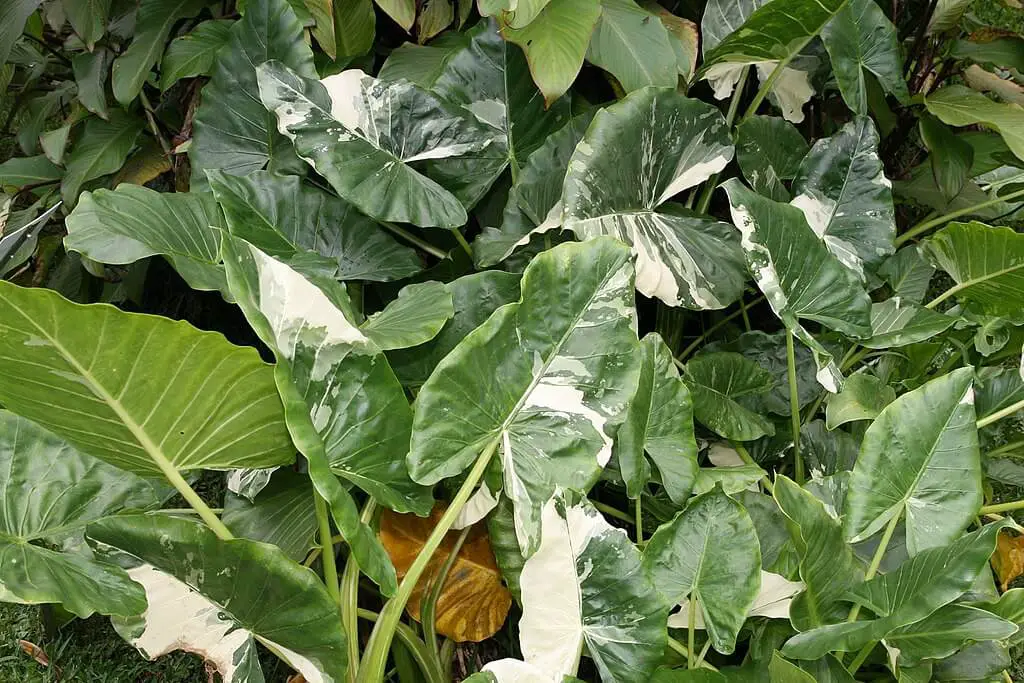Giant taros are often used as ornamental plants. They are excellent for creating dense, verdant gardens and borders. Giant taro is also an edible staple for hundreds of millions of people worldwide, but it must be consumed with caution.
Alocasia macrorrhiza is a perennial tropical plant belonging to the Araceae family. Other common names include giant taro, giant elephant ear, and upright elephant ear.
Their huge heart-shaped leaves resemble the ears of an elephant and are covered in tiny, waxy bumps. These allow rainwater to easily roll off the leaf, gathering dirt and cleaning it in the process.
Giant taro plant profile
The giant taro belongs to the genus Alocasia which includes nearly 100 species. The Alocasia macrorrhizas variegata is a variety of giant taro whose large leaves have splotchy patches of white. These unique evergreens are often grown for ornamental purposes.
What Are You Foraging For Right Now?
We're thrilled to hear your ideas. What would you like to submit today? Feel free to share your thoughts and experiences with us.
Alocasia macrorrhizas are often mistaken for a Colocasia plant. The word Alocasia means “like but not Colocasia.” Both contain large leaves shaped like elephant ears. The difference is giant taro leaves stand upright, and Colocasia leaves droop downwards.
Alocasia macrorrhizas are typically an under-layer evergreen plant found on dense rainforest floors. In some regions, they grow near ponds and other wetlands.
Giant taro is native to areas such as:
- Sri Lanka
- Southeast Asia
- New Guinea
- Indonesia
- Pacific Islands
Giant taro produces a root system of both tubers and rhizomes which grow up to a foot long and 1/2 a foot thick, taking up to two years to develop fully.
Tall, strong, rigid stalks rise vertically up to 6 feet high from the thick trunk of this giant alocasia. The glossy, thick green leaves grow 2-4 feet wide and 3-6 feet long.
Giant taro must be this large to absorb enough sunlight from the base of the dense rainforest floor.
The flowers of giant taro resemble calla lily flowers. The spathe and spadix are greenish-yellow, and the flowers are greenish-white.
They usually bloom in the spring or summer. While the flowers have little to no scent, pollinators like bees attract them.

How big can giant taro get?
The giant taro grows 12-15 feet high and 6-8 feet wide. It is a fast-growing species and reaches maturity in about two years.
Alocasia macrorrhizas are susceptible to pests such as:
- spider mites
- mealy bugs
- aphids
- scale
Use neem oil or a cotton ball dipped in alcohol to rid your plant of these pests.
Giant taro is also susceptible to diseases like:
- leaf spot
- Southern blight
- rot
- powdery mildew
- Xanthomonas
These diseases usually occur when the environment is too wet. Be sure to water your giant taro during the day to allow time for the leaves and roots to dry by evening.
Is giant taro toxic in any way?
Giant taro is toxic to humans and pets when consumed raw. Take caution with children and pets, so they do not handle or eat the plant.
Most varieties of Alocasia contain calcium oxalate. These are needle-like, toxic crystals. Boiling the leaves, stems, and tubers is vital to remove the toxin.
Skin contact and/or ingesting Alocasia macrorrhiza can cause:
- Itching of the skin, lips, and mouth
- Burning of the mouth or throat
- Constriction of airways
- Vomiting, diarrhea, or other gastrointestinal issues
Can we eat giant taro?
Yes, giant taro can be consumed. It seems odd to eat a plant known to be toxic, yet it is a food staple for cultures all over the world.
The trick to using giant taro in the kitchen is to be extremely careful when handling and cooking it.
Use gloves or utensils to protect your skin, and be sure you cook it long enough to remove the calcium oxalate completely.
Some tricks to help remove the toxin are:
- Boil with a pinch of baking soda
- Soak overnight, drain water in the morning, and then cook
Considered a vegetable, the tubers are a substitute for potatoes in some parts of the world where it’s too humid to grow potatoes, corn, and other starchy crops. The stems and leaves can also be used if prepared correctly.
Giant taros are high in:
- Carbohydrates (the highest of all the edible aroids)
- Vitamins B and C
- Iron
- Potassium
- Phosphorus
- Carotene

Using Giant taro in the kitchen
The corm, or the bulbo-tuber, is large and fleshy. This is the part of the giant taro most often consumed and is similar in taste to potatoes.
The most common method of eating the tubers is simply peeling and boiling them. They can also be roasted, fried, or mashed.
In Hawaii, they pound the roots into an edible paste they call Poi. In Guam, they peel, slice, and boil the tubers with coconut milk. They can also be boiled, dried, and then ground into flour.
Taro root fries and chips are a popular way to use the tubers and make a delicious snack. They are a healthier alternative to french fries and potato chips.
The leaves and stems of Alocasia macrorrhiza can also be used in dishes and taste similar to spinach. The thick stems have a white interior that can be cooked, boiled, dried, and ground into flour.
Choose young leaves, cutting them right after opening (more will grow back in its place). The leaves and stems must be boiled twice to remove the calcium oxalate and bitterly pungent flavor.
A popular dish in Borneo is fermented rice leaves:
- Take cooked rice and mix with yeast
- Wrap in giant taro leaf to ferment
- Keep in a cool, dry place for 2-3 days or until rice is fermented but not yet turned to alcohol
- Discard the leaf and consume rice
This method works with meat or vegetables too.
Giant taro tubers, leaves, and stems absorb flavor well. Think of them as a vegetable, and add to dishes like soups, stews, and roasts.
Giant taro can be harvested any time of the year without disrupting its growth cycle. Yet it requires around 200 days after being planted to reach maturity and be able to be harvested.
Giant taro: growing and plant care
Alocasia macrorrhiza and Alocasia macrorrhiza variegata are tropical plants, and so their environment needs to mimic those conditions. They do best in warm, humid, moist climates. In the United States, they thrive in USDA hardiness zones 9-12.
The giant taro likes part shade and indirect sunlight. Full sun can scorch the leaves, damaging the plant. They are humidity tolerant but do not tolerate frost or even temperatures below 50 degrees Fahrenheit.
These plants have a low drought tolerance, so they do best in moist, well-draining soils like clay, loam, and sand. Giant taro must be watered regularly, although it can be reduced in winter.
Underwatering can cause problems like slow growth, browning, and leaves yellowing. Overwatering will create root rot. This causes the leaves to turn yellow due to lack of nutrition and the base of the plant to collapse, killing the plant.
To grow either Alocasia macrorrhiza or Alocasia macrorrhiza variegata, you can buy tubers from a local nursery or propagate them from an established plant.
Propagation through basal division is the best method:
- Dig up the entire plant and check for tubers. Separate them from the main plant, and replant in the ground.
- Plant the tubers 6 inches deep and add a couple of inches of soil, spacing 1-2 feet apart in rows 3 feet apart. Water often and use fertilizer or compost high in potassium. You will see sprouts in about a week.
- If your climate is too cool to grow giant taro outdoors, you can pot them to use as a houseplant. Choose a large, deep pot, and plant the root vertically. Be sure the soil stays warm and moist.
As indoor plants, they require a lot of fertilization. It’s recommended to use houseplant fertilizer about every two weeks or a slow-release fertilizer. They will also need to be occasionally pruned to avoid getting too large.
Alocasia macrorrhiza should be repotted every 2-3 years, and Alocasia macrorrhiza variegata needs to be repotted every year. This helps prevent root rot.
Another option for growing giant taro if you live in a cooler climate is to treat them like bulbs, digging them up in the fall and re-planting them in the spring after the last frost date.
Rachel Schmeltzer is a writer, mom, teacher, and dreamer. She enjoys reading, traveling, history, spending time with her boys and her cats, and foraging in the woods of Minnesota.

